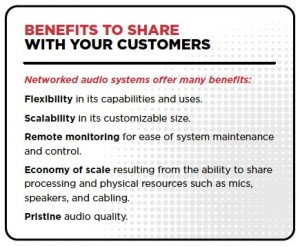To conclude my 4-part series on networked audio, I’d like to briefly discuss the future of networked audio, and how it relates to the AV/IT convergence.
 The ability to route audio from any input in any room to any output in any room has unsurpassed potential for end users in their day-to-day operations, and integrators in their value-add to their customers. Now that you know more about networks, how audio moves on a network, and what real-world applications of networked audio can look like, you’ll be better equipped to communicate the importance and value of your audio solutions to IT professionals and end users alike.
The ability to route audio from any input in any room to any output in any room has unsurpassed potential for end users in their day-to-day operations, and integrators in their value-add to their customers. Now that you know more about networks, how audio moves on a network, and what real-world applications of networked audio can look like, you’ll be better equipped to communicate the importance and value of your audio solutions to IT professionals and end users alike.
The promise of networked audio as a maturing and robust communications technology is that eventually most, if not all, manufacturers will produce audio/video products that will be interoperable with each other. In the near future, and even at present, many more audio/video manufacturers are deciding to adopt open standards-based technologies, such as AVB, as opposed to reinventing the wheel with proprietary transport technologies.
Proprietary technologies may end up costing the customer more because they get locked into one brand, or technology platform, instead of being able to access the interoperability, and best-fit hardware found with open standards-based platforms.
This too, is part of the convergence of AV and IT. The IT philosophy of interoperability is killing off the old AV philosophy of “You must buy everything from the same vendor for the system to work properly.” The new era of AV/IT convergence, and the high usability of networked audio across all environments, promises expanded capabilities and opportunities for end users of both industries.